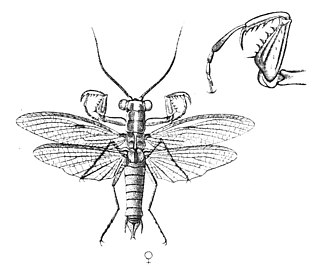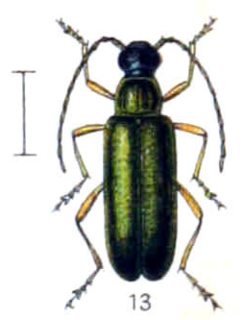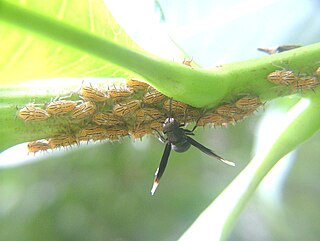
Squirrels are members of the family Sciuridae, a family that includes small or medium-size rodents. The squirrel family includes tree squirrels, ground squirrels, and flying squirrels. Squirrels are indigenous to the Americas, Eurasia, and Africa, and were introduced by humans to Australia. The earliest known fossilized squirrels date from the Eocene epoch, and among other living rodent families, the squirrels are most closely related to the mountain beaver and to the dormice.

In biology, taxonomy is the scientific study of naming, defining (circumscribing) and classifying groups of biological organisms based on shared characteristics. Organisms are grouped into taxa and these groups are given a taxonomic rank; groups of a given rank can be aggregated to form a more inclusive group of higher rank, thus creating a taxonomic hierarchy. The principal ranks in modern use are domain, kingdom, phylum, class, order, family, genus, and species. The Swedish botanist Carl Linnaeus is regarded as the founder of the current system of taxonomy, as he developed a ranked system known as Linnaean taxonomy for categorizing organisms and binominal nomenclature for naming organisms.
Genus/ˈdʒiː.nəs/ is a taxonomic rank used in the biological classification of living and fossil organisms as well as viruses. In the hierarchy of biological classification, genus comes above species and below family. In binomial nomenclature, the genus name forms the first part of the binomial species name for each species within the genus.

Biodiversity is the biological variety and variability of life on Earth. Biodiversity is a measure of variation at the genetic, species, and ecosystem level. Terrestrial biodiversity is usually greater near the equator, which is the result of the warm climate and high primary productivity. Biodiversity is not distributed evenly on Earth, and is richer in the tropics. These tropical forest ecosystems cover less than ten percent of earth's surface, and contain about ninety percent of the world's species. Marine biodiversity is usually higher along coasts in the Western Pacific, where sea surface temperature is highest, and in the mid-latitudinal band in all oceans. There are latitudinal gradients in species diversity. Biodiversity generally tends to cluster in hotspots, and has been increasing through time, but will be likely to slow in the future as a primary result of deforestation. It encompasses the evolutionary, ecological, and cultural processes that sustain life.

Extinction is the termination of a kind of organism or of a group of children (taxon), usually a species. The moment of extinction is generally considered to be the death of the last individual of the species, although the capacity to breed and recover may have been lost before this point. Because a species' potential range may be very large, determining this moment is difficult, and is usually done retrospectively. This difficulty leads to phenomena such as Lazarus taxa, where a species presumed extinct abruptly "reappears" after a period of apparent absence.

The International Union for Conservation of Nature (IUCN) Red List of Threatened Species, founded in 1964, is the world's most comprehensive inventory of the global conservation status of biological species. It uses a set of precise criteria to evaluate the extinction risk of thousands of species and subspecies. These criteria are relevant to all species and all regions of the world. With its strong scientific base, the IUCN Red List is recognized as the most authoritative guide to the status of biological diversity. A series of Regional Red Lists are produced by countries or organizations, which assess the risk of extinction to species within a political management unit.

Endemism is the state of a species being found in to a single defined geographic location, such as an island, state, nation, country or other defined zone; organisms that are indigenous to a place are not endemic to it if they are also found elsewhere. For example, the Cape sugarbird is found exclusively in southwestern South Africa and is therefore said to be endemic to that particular part of the world.

The conservation status of a group of organisms indicates whether the group still exists and how likely the group is to become extinct in the near future. Many factors are taken into account when assessing conservation status: not simply the number of individuals remaining, but the overall increase or decrease in the population over time, breeding success rates, and known threats. Various systems of conservation status exist and are in use at international, multi-country, national and local levels as well as for consumer use.

Ant mimicry or myrmecomorphy is mimicry of ants by other organisms. Ants are abundant all over the world, and potential predators that rely on vision to identify their prey, such as birds and wasps, normally avoid them, because they are either unpalatable or aggressive. Spiders are the most common ant mimics. Additionally, some arthropods mimic ants to escape predation, while others mimic ants anatomically and behaviourally to hunt ants in aggressive mimicry. Ant mimicry has existed almost as long as ants themselves; the earliest ant mimics in the fossil record appear in the mid Cretaceous alongside the earliest ants. Indeed one of the earliest, Burmomyrma, was initially classified as an ant.
Mantoida brunneriana is a species of praying mantis in the family Mantoididae. It is found in Bolivia, Brazil, French Guiana, Paraguay, and Venezuela.

Mantoida nitida is a species of praying mantis in the family Mantoididae. It is found in Mexico.

An endangered species is a species that is very likely to become extinct in the near future, either worldwide or in a particular political jurisdiction. Endangered species may be at risk due to factors such as habitat loss, poaching and invasive species. The International Union for Conservation of Nature (IUCN) Red List lists the global conservation status of many species, and various other agencies assess the status of species within particular areas. Many nations have laws that protect conservation-reliant species which, for example, forbid hunting, restrict land development, or create protected areas. Some endangered species are the target of extensive conservation efforts such as captive breeding and habitat restoration.
In biology, a species is the basic unit of classification and a taxonomic rank of an organism, as well as a unit of biodiversity. A species is often defined as the largest group of organisms in which any two individuals of the appropriate sexes or mating types can produce fertile offspring, typically by sexual reproduction. Other ways of defining species include their karyotype, DNA sequence, morphology, behaviour or ecological niche. In addition, paleontologists use the concept of the chronospecies since fossil reproduction cannot be examined.

Mantoididae is a family of praying mantises which contains Neotropical species of praying mantises from tropical North and South America. The family was formerly represented by the sole genus Mantoida, until the genus Paramantoida was described in 2014 and Vespamantoida in 2019. The family differs from the closely related Chaeteessidae in having an apical claw on the fore tibiae which are also less curved. Males have ocelli and a cylindrical body shape, unlike the dorsoventrally flattened Chaeteessidae. The cerci are also shorter.

Grammoptera is a genus of beetles in the family Cerambycidae, distributed primarily in the Northern Hemisphere.
Thyellocerus fulgidipennis is a species of beetle in the family Cerambycidae, the only species in the genus Thyellocerus.

Parachartergus is a genus of epiponine social wasps belonging to the subfamily Polistinae. Species include:
Vespamantoida wherleyi is a species of praying mantis that mimics a wasp. It was discovered in 2013 at a research station near the Amazon River in northern Peru. The discovery resulted in erecting a new genus, Vespamantoida. This mantis has a red/orange colored body and black pattern. Besides the coloration, it has the body shape of and displayed walking and antenna movements similar to a wasp. This mantis is closely related to Mantoida toulgoeti as both species have a distinct foreleg synapomorphy.











